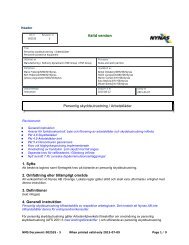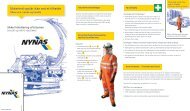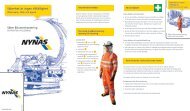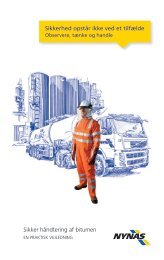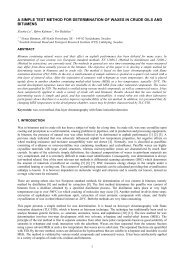High Resistance Polymermodified Binders to Secure ... - Nynas
High Resistance Polymermodified Binders to Secure ... - Nynas
High Resistance Polymermodified Binders to Secure ... - Nynas
Create successful ePaper yourself
Turn your PDF publications into a flip-book with our unique Google optimized e-Paper software.
Dr.-Ing. Ingo Nösler<br />
Product Support Manager Central Europe, <strong>Nynas</strong> Bitumen, Belgium<br />
<strong>High</strong> <strong>Resistance</strong> <strong>Polymermodified</strong> <strong>Binders</strong><br />
<strong>to</strong> <strong>Secure</strong> Durable Asphalt Pavements<br />
Summary<br />
New high polymermodified binders with high resistance properties will be presented.<br />
These special binders have additionally a viscosity-reduced performance that allows<br />
a good workability and compaction. The new high resistance polymermodified<br />
binders are especially developed for asphalt pavements with high and static traffic<br />
loading like junction areas, roundabouts, traffic jam areas, bus stations, high gradient<br />
roads, container terminals, etc.<br />
The range of plasticity of these high resistance binders amounts nearly 100°C. The<br />
heat stability amounts more than double measured by complex shear modulus and<br />
compared with a standard PmB. The behaviour at low temperatures is not affected<br />
measured with the Bending Beam Rheometer. The asphalt performance for binder<br />
course asphalt and s<strong>to</strong>ne mastic asphalt tested with the wheel-rutting tester (steel<br />
wheel at 60°C) is exceptional well.<br />
This paper is describing these special high resistance polymermodified binders and<br />
their possibilities of usage <strong>to</strong> ensure durable asphalt pavements. Furthermore the<br />
paper is giving recommendations for special applications, experiences and examples<br />
from German high traffic loaded areas.<br />
1. Introduction<br />
Static and high loading in addition with high temperatures are the worst mode of<br />
loading for asphalt pavements. In such cases permanent deformations are preprogrammed.<br />
The resistance <strong>to</strong> permanent deformations could be improved by using<br />
harder binders but mostly as a consequence of other performance related properties<br />
like durability and cold behaviour are decreasing.<br />
For such a special asphalt pavements with high and static traffic loading like junction<br />
areas, roundabouts, traffic jam areas, bus stations, high gradient roads, container<br />
terminals, etc. new high polymermodified binders with high resistance properties are<br />
necessary. The target was <strong>to</strong> develop special high polymermodified binders <strong>to</strong><br />
ensure durable asphalt pavements who should have additionally a viscosity reduced<br />
performance that allows a good workability and a good compaction.<br />
In the German delivery specification of polymermodified binder (TL PmB, issue 2001)<br />
is one high polymermodified binder specified. Concerning the PmB 40/100-65 H the<br />
target of the new development of the special PmB was <strong>to</strong> increase the stability of the<br />
asphalt pavement <strong>to</strong> ensure durable pavements in addition of an increase of the<br />
workability. With this context the property of the cold behaviour should be the same<br />
or even better. The TL PmB also include volunteer additional test values like the<br />
Dynamic Sheer Rheometer (DSR), the Force Ductility (FD) and the Bending Beam
Rheometer (BBR) which make it even better <strong>to</strong> describe the performance related<br />
binder properties.<br />
2. Development of PmB with <strong>High</strong> <strong>Resistance</strong> (HR) Properties<br />
<strong>Nynas</strong> Bitumen developed two grades of <strong>High</strong> <strong>Resistance</strong> (HR) polymermodified<br />
binders that are named in the style of the German TL PmB concerning the PmB 25<br />
and the PmB 45.<br />
Both grades the Nypol 25 HR and the Nypol 45 HR have a higher polymer content<br />
based on selected SBS with special additives by using venezuelan base bitumen<br />
which in combination guaranteed the postulated performance. Both grades are of<br />
course cross-linked <strong>to</strong> guarantee the necessary s<strong>to</strong>rage stability especially for higher<br />
polymermodified binders.<br />
2.1 Handling and S<strong>to</strong>rage<br />
The <strong>High</strong> <strong>Resistance</strong> PmB’s should be treated as a normal high polymermodified<br />
binder. The delivery and s<strong>to</strong>rage temperature is around 180 °C. The HR PmB’s are<br />
stable in s<strong>to</strong>rage but for periods of longer than one week the s<strong>to</strong>rage temperature<br />
should be lowered <strong>to</strong> around 140 °C. Reheating should take place gradually, where<br />
possible in a tank with an agita<strong>to</strong>r or with simultaneous pump circulation. The s<strong>to</strong>rage<br />
temperature should not exceed 190 °C.<br />
2.2 Mixing and Transport<br />
The asphalt which is made with the HR PmB’s is mixed in the usual sequence where<br />
the temperature of the binder should be around 180 °C. The temperature of the<br />
asphalt mixture should be between 170 °C and 180 °C. The mixture can be s<strong>to</strong>red<br />
briefly in silos provided these are designed <strong>to</strong> prevent caking at the silo outlet, e.g.<br />
with stainless steel lining and heated silo shutters. The mixture must be transported<br />
that it cools down as less as possible. Covering the mix is absolutely essential.<br />
2.3 Laying, Compaction and Testing<br />
The asphalt mixture made with HR PmB’s should in principle be laid mechanically;<br />
manual laying should be limited <strong>to</strong> an absolute minimum. The laying temperature<br />
should be around 170 °C. Compaction should take place with heavy static rollers<br />
and / or heavy vibra<strong>to</strong>ry rollers, and be completed at a mixture temperature of at least<br />
100 °C.<br />
The HR PmB’s can be extracted from the asphalt mixture with trichloroethylene or<br />
<strong>to</strong>luene. The extraction time must be extended by at least 30 minutes that all<br />
polymers and additives are reliably dissolved.<br />
2.4 Performance of <strong>High</strong> <strong>Resistance</strong> (HR) PmB<br />
The development of the high resistance PmB started with the project of the Container<br />
Terminal in Hamburg (Germany). The tender described the specification for an<br />
special higher polymermodified binder. This project is described in further details in<br />
chapter 3.1.
In the table 1 is shown the tender specification in comparison <strong>to</strong> the new developed<br />
high resistance PmB – Nypol 25 HR. Typical applications for Nypol 25 HR are heavy<br />
duty industrial areas such as port unloading areas, container terminals or traffic areas<br />
with high static loading such as truck parks and bus stations. Nypol 25 HR is used in<br />
s<strong>to</strong>ne mastic asphalt, asphalt concrete and asphalt binder course for extraordinary<br />
loading.<br />
Furthermore you can see the properties of the high resistance PmB Nypol 45 HR<br />
which was developed for the application of asphalt mixtures for heavy duty traffic<br />
areas such as road class up <strong>to</strong> SV, junction areas, roundabouts, traffic jam areas,<br />
bus stations, high gradient roads, etc.<br />
2.4.1 Performance Testing of <strong>High</strong> <strong>Resistance</strong> (HR) PmB<br />
For the behaviour at low temperatures the stiffness at -16 °C [Mpa] was measured by<br />
using the Bending Beam Rheometer (BBR) in the style of the description of<br />
AASHTO TP1-97. The Force Ductility (FD) at 25 °C was measured in the style of the<br />
description of TL PmB – Appendix B. For the deformation behaviour the Complex<br />
Sheer Modulus G* and the Phase Angle δ was measured at 60 °C by using the<br />
Dynamic Sheer Rheometer (DSR) in the style of the description of AASHTO TP1-97<br />
with the test conditions as follows:<br />
Frequency: 1,59 Hz<br />
Plate Diameter: 25 mm<br />
Plate Gap: 1 mm<br />
Deformation: 0,05 mm<br />
Temperature Control: Water Bath<br />
The heat stability amounts more than double measured by complex shear modulus<br />
and compared with a standard PmB. The behaviour at low temperatures is not<br />
affected measured with the Bending Beam Rheometer.
Table 1: German specification for PmB deliveries (TL PmB, 2001) in comparison with<br />
different higher polymermodified binders<br />
Properties Unit<br />
TL PmB<br />
40/100-<br />
65 H<br />
Method<br />
DIN EN -<br />
Nypol<br />
25 HR<br />
CT - Tender<br />
Specification<br />
Nypol<br />
45 HR<br />
Penetration (100 g, 5 s, 25°C) mm/10 40 – 100 1426 10 – 35 60 – 80 20 – 50<br />
Softening Point Ring and Ball °C ≥ 65,0 1427 85 – 100 85 – 105 75 – 85<br />
Breaking Point Fraass °C ≤ -15 12593 < -5 < -16 -10<br />
Ductility at 25 °C cm ≥ 60 DIN 52013 > 30 > 100 > 50<br />
Elastic Recovery at 25 °C % ≥ 70 13398 > 70 > 90 > 50<br />
S<strong>to</strong>rage Stability<br />
Different of Softening Point<br />
Change of Softening Point<br />
after Ageing (RFT)<br />
– Increase<br />
– Decrease<br />
Change of Penetration after<br />
Ageing (RFT)<br />
– Remaining<br />
– Increase<br />
Ductility at 25 °C after<br />
Ageing (RFT)<br />
Elastic Recovery at 25 °C<br />
after Ageing (RFT) at 20 cm<br />
String Length<br />
Behaviour at Low<br />
Temperatures<br />
Bending Beam Rheometer<br />
(BBR)<br />
- Stiffness at – 16 °C<br />
Force Ductility (FD) at 25 °C<br />
Deformation Behaviour<br />
Dynamic Sheer Rheometer<br />
(DSR) at 60 °C<br />
- complex Sheer Modulus G*<br />
- Phase Angle δ<br />
°C ≤ 2,0<br />
°C<br />
°C<br />
%<br />
%<br />
≤ 8,0<br />
≤ 5,0<br />
≥ 60<br />
≤ 10<br />
cm ≥ 30<br />
%<br />
≥ 50<br />
13399 &<br />
1427<br />
12607-3 &<br />
1427<br />
12606-3 &<br />
1426<br />
12607-3 &<br />
DIN 52013<br />
12607-3 &<br />
13398<br />
< 2,0 < 2,0 < 2,0<br />
< 8,0<br />
< 2,0<br />
> 60<br />
< 10<br />
< 6,0<br />
< 8,0<br />
> 60<br />
< 10<br />
< 8,0<br />
< 2,0<br />
> 60<br />
< 10<br />
> 20 > 40 > 30<br />
> 60<br />
Additional Volunteer Requirements and Test Methods<br />
MPa<br />
J<br />
Pa<br />
°<br />
≤ 200<br />
≥ 1<br />
≥ 3500<br />
≤ 75<br />
AASHTO -<br />
TP1<br />
TL PmB –<br />
Appendix B<br />
AASHTO -<br />
TP 5<br />
390 2)<br />
< 400<br />
1,9 2)<br />
> 1<br />
66.000 2)<br />
60 2)<br />
> 30.000<br />
< 65<br />
< 70 1)<br />
138 2)<br />
0,3 2)<br />
4.750 2)<br />
57 2)<br />
> 50<br />
175 2)<br />
< 300<br />
> 1<br />
16.000 2)<br />
64 2)<br />
> 10.000<br />
< 70<br />
CT – Tender Specification: For the tender of the Container Terminal Hamburg required<br />
properties of the higher polymermodified binder that was<br />
advertised for the bid<br />
1) With 10 cm String Length 2) Typical Values
3. Application of <strong>High</strong> <strong>Resistance</strong> <strong>Polymermodified</strong> <strong>Binders</strong><br />
The following chapters describing more detailed the practical application of the<br />
developed high resistance PmB’s. Already in the Saison 2003 both high resistance<br />
PmB’s, i.e. Nypol 25 HR and Nypol 45 HR, where used for several constructions<br />
which where stressed by high and static traffic loading and where a durable asphalt<br />
pavement are postulated. The HR PmB’s was used for asphalt binder courses 0/16 S<br />
and 0/22 S, for asphalt concrete 0/11 S and for s<strong>to</strong>ne mastic asphalt 0/8 S and<br />
0/16 S. Two of these examples will be described in the following chapters.<br />
3.1 Application Example Container Terminal Hamburg<br />
The container handling of the harbour of Hamburg had a growth last year with more<br />
than 10 percentage and is as a consequence the number one in Europe. More than 3<br />
million containers were unloaded. Laid one after another would be a line from the<br />
North Pole <strong>to</strong> the South Pole.<br />
For the upgrading of the container handling in the harbour of Hamburg the Container<br />
Terminal Altenwerder is building up <strong>to</strong> the end of 2004. It is more than self-evident<br />
that the client is expecting a durable asphalt pavement. The demand of the client<br />
concerning the pavement design looks as follows:<br />
200 Van-Carrier<br />
Axle Loading: 125 kN/day<br />
365 days/year<br />
Total Usage: 20 years<br />
With the above mentioned input for the pavement design resulted the following<br />
pavement construction by using a special high polymermodified binder:<br />
30 cm – Gravel Roadbase 0/45<br />
8 cm – Asphalt Binder Course 0/16 S<br />
6 cm – S<strong>to</strong>ne Mastic Asphalt 0/16 S<br />
The grading curve of the used asphalt binder course 0/16 S is shown in the figure 1.<br />
Figure 1: Binder Course Asphalt 0/16 S – Container Terminal Hamburg
3.1.1 German Wheel Tracking Test<br />
The German Wheel Tracking test is used <strong>to</strong> measure in the labora<strong>to</strong>ry the resistance<br />
against deformation and stripping of the binders on compacted asphalt samples.<br />
Asphalt plates can be tested dry or under water with loaded steel or rubber coated<br />
wheels. The test conditions are shown in the documentation (TP A StB).<br />
The test is mainly used for extended qualification tests and as a <strong>to</strong>ol for development<br />
of improved mix formulations or development of improved bituminous binders. Great<br />
experience is based on asphalt binder mix formulations measured normally at 50°C<br />
under water with a steel wheel. A principal drawing of the test arrangement is shown<br />
in figure 2.<br />
loading: 700 N<br />
20.000 wheel passes<br />
test wheel<br />
∅ 20,3 cm / width 4,7 cm<br />
drive wheel<br />
specimen<br />
26 x 32 x 5 cm<br />
Figure 2: Principle of the German Wheel Tracking Test<br />
water bath<br />
In the German Wheel Tracking Tester two asphalt specimen of 260 x 320 x 50 are<br />
tested simultaneously. The steel wheels charge the specimen with a load of 700 N.<br />
The results are indicated as vertical movement of the wheels in dependence of the<br />
number of passes. They are graphically shown as the mean of the two samples.<br />
Normally the results after 20.000 wheel passes are stated. The speed of the test<br />
wheels is 53 min -1 . The test is terminated earlier when a maximum rut depth of 20<br />
mm is reached.<br />
For the compaction of the test plates a Linear Kneading Compac<strong>to</strong>r was used. This<br />
compac<strong>to</strong>r has shown good correlation with field compaction. The calculated amount<br />
of asphalt is weighed and put in<strong>to</strong> a metal mould of 260 x 320 mm. Steel lamellas of<br />
100 x 10 x 260 mm are placed on <strong>to</strong>p of the uncompacted sample in the mould. The<br />
necessary amount of asphalt is calculated on basis of the bulk density of a Marshall<br />
Test Specimen. By help of a hydraulic press a steel wheel is progressively lowered<br />
until the steel lamellas are even with the upper border of the mould.<br />
The table 2 shows the exceptional well results of the wheel-tracking test. The test<br />
was done at 60 °C (because the values for 50 °C were <strong>to</strong>o small) water temperature<br />
and with a steel wheel. Both values for the used asphalt mixture 0/16 S are below 2<br />
mm. The German limit for binder courses is below 3,5 mm. In comparison with the<br />
Nypol 25 HR you can see in table 2 the results of the higher polymermodified binder<br />
that was advertised for the bid from the tender of the Container Terminal Hamburg.<br />
For the mixture of the binder course it is similar the same behaviour. For the s<strong>to</strong>ne<br />
mastic asphalt the Nypol 25 HR reach a better result of roughly 30 percentage.
Table 2: Results of German Wheel Rutting Test – Nypol 25 HR (Steel Wheel at 60 °C)<br />
Binder Course<br />
Asphalt 0/16 S<br />
S<strong>to</strong>ne Mastic<br />
Asphalt 0/11 S<br />
S<strong>to</strong>ne Mastic<br />
Asphalt 0/16 S<br />
Binder Content<br />
[M.-%]<br />
Air Void Content<br />
[Vol.-%]<br />
Rut Depth at 60 °C<br />
[mm]<br />
Rut Depth at 60 °C<br />
Tender Product [mm]<br />
4,2 5,2 1,7 1,6<br />
7,1 3,7 2,5 ---<br />
5,2 3,7 1,4 2,1<br />
3.1.2 German Compactability Test<br />
By using high polymermodified binders with high resistance properties mostly as a<br />
consequence of the higher softening point the workability of the final asphalt mixture<br />
is decreasing. To counteract this negative property the high resistance PmB’s<br />
including a special viscosity reduced additive that allows a good workability and a<br />
good compaction.<br />
To quantify the good workability and the good compactability the German compactability<br />
test was done for the asphalt binder course 0/16 S and the s<strong>to</strong>ne mastic<br />
asphalt 0/16 S. The compaction resistance was measured in the style of the German<br />
test description by using Marshall specimen. At this the compaction resistance is<br />
quantify by measuring the change of the thickness of the specimen in dependence<br />
on the compaction work. For this 100 compaction blows on each specimen side is<br />
used by measuring the change of the specimen thickness. In figure 3 you can find<br />
the result for the asphalt binder course 0/16 S by using the Nypol 25 HR.<br />
Figure 3: Evaluation of the Compactability – Asphalt Binder Course 0/16 S by using<br />
Nypol 25 HR
The value D for the compaction resistance is resulting from the iteration calculation of<br />
the exponential function of the compaction. The function is build with the decreased<br />
thickness of the specimen in connection with the number of blows. The figure 4<br />
shows the result for the s<strong>to</strong>ne mastic asphalt 0/16 S by using the Nypol 25 HR.<br />
Figure 4: Evaluation of the Compactability – S<strong>to</strong>ne Mastic Asphalt 0/16 S by using<br />
Nypol 25 HR<br />
In comparison with the Nypol 25 HR you can see in table 3 the results of the German<br />
compactability test from the higher polymermodified binder that was advertised for<br />
the bid from the tender of the Container Terminal Hamburg. For the mixture of the<br />
binder course it is again similar the same behaviour. For the s<strong>to</strong>ne mastic asphalt the<br />
Nypol 25 HR reach a better result of roughly 10 percentage for the compactability<br />
and out of it for the workability.<br />
Table 3: Results of German Compactability Test – Container Terminal Hamburg<br />
Binder Course<br />
Asphalt 0/16 S<br />
S<strong>to</strong>ne Mastic<br />
Asphalt 0/16 S<br />
Compaction <strong>Resistance</strong> D [21 Nm]<br />
Nypol 25 HR<br />
Compaction <strong>Resistance</strong> D [21 Nm]<br />
Tender Product<br />
40,6 40,4<br />
37,7 41,1
3.2 Application Example Bus Station<br />
Due <strong>to</strong> the good experiences of the high resistance PmB the Nypol 25 HR was also<br />
used for the remediation of several areas of the bus station in Hamm (Germany). The<br />
old areas made out of asphalt around the central platform had huge deformations<br />
and had <strong>to</strong> be rehabilitated.<br />
The old asphalt binder course and the old s<strong>to</strong>ne mastic asphalt were participating in<br />
the huge deformations. The optical impression of the whole Bus Square should not<br />
be changed, i.e. other constructions like concrete or composite pavement structures<br />
was not possible. The rehabilitation had <strong>to</strong> be done in an asphalt construction. After<br />
milling of the both old layers a new construction with binder course asphalt 0/22 S<br />
and with s<strong>to</strong>ne mastic asphalt 0/11 S by using the Nypol 25 HR was build. In the<br />
following table 4 the results of the wheel tracking tests are shown. The results are<br />
extremely good compare with the German limit of 3,5 mm for binder courses. The rut<br />
depth for the surface course is below 1,0 mm.<br />
Table 4: Results of German Wheel Rutting Test – Nypol 25 HR (Steel Wheel at 50 °C)<br />
Binder Course<br />
Asphalt 0/22 S<br />
S<strong>to</strong>ne Mastic<br />
Asphalt 0/11 S<br />
Binder Content<br />
[M.-%]<br />
Air Void Content<br />
[Vol.-%]<br />
Rut Depth at 50 °C<br />
[mm]<br />
4,2 6,3 2,2<br />
6,8 4,2 0,8<br />
The paving of the asphalt mixtures were made with a conventional paver by using a<br />
9,5 t smooth-wheeled vibration roller. The compaction was controlled with a Troxler<br />
probe. Due <strong>to</strong> the good workability of the HR PmB paving temperatures between 160<br />
and 170 °C were used without any problems for the compaction of the asphalt<br />
mixture. The demand compaction degree of 97 % was achieved. The laying was<br />
done during the hot summer period in August 2004. Referring <strong>to</strong> this the Bus Square<br />
was closed for three days <strong>to</strong> guarantee the cooling down. On Monday morning the<br />
bus traffic started again.<br />
4. Conclusions<br />
Based on the experiences of the high resistance high polymermodified binder is<br />
resulting that with the Nypol 25 HR and the Nypol 45 HR two binders are available<br />
which are able <strong>to</strong> ensure durable asphalt pavement for different applications.<br />
The range of plasticity of these high resistance binders amounts nearly 100°C. The<br />
heat stability amounts more than double measured by complex shear modulus and<br />
compared with a standard PmB. The behaviour at low temperatures is not affected<br />
measured with the Bending Beam Rheometer. The asphalt performance for binder<br />
course asphalt and s<strong>to</strong>ne mastic asphalt tested with the wheel-rutting tester (steel<br />
wheel at 60°C) is exceptional well.<br />
5. References<br />
Barth, R.: Das <strong>Nynas</strong> - Spezialbindemittel für sehr hoch beanspruchte Verkehrsflächen,<br />
Performance, Issue 3, 2003


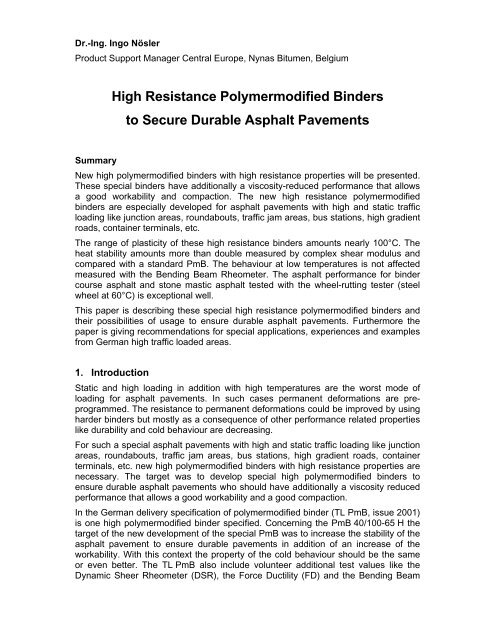
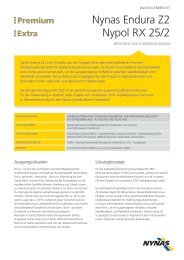
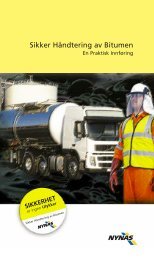

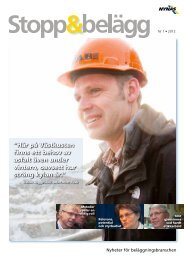
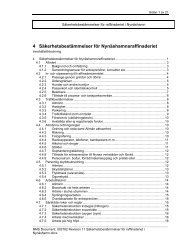
![Säkerhetsbestämmelser Gbg rev 5.ppt [Compatibility Mode] - Nynas](https://img.yumpu.com/18742268/1/190x146/sakerhetsbestammelser-gbg-rev-5ppt-compatibility-mode-nynas.jpg?quality=85)
